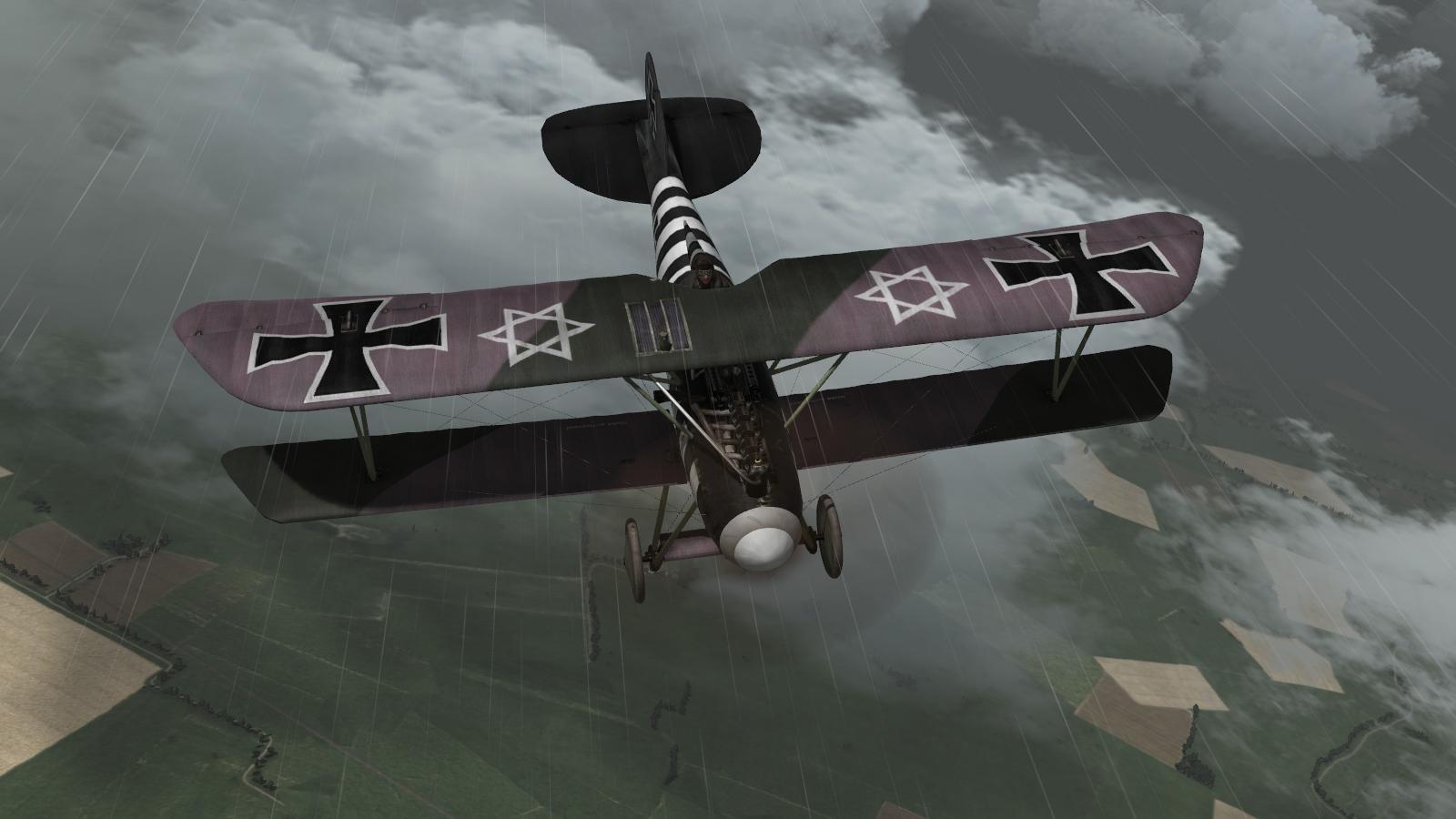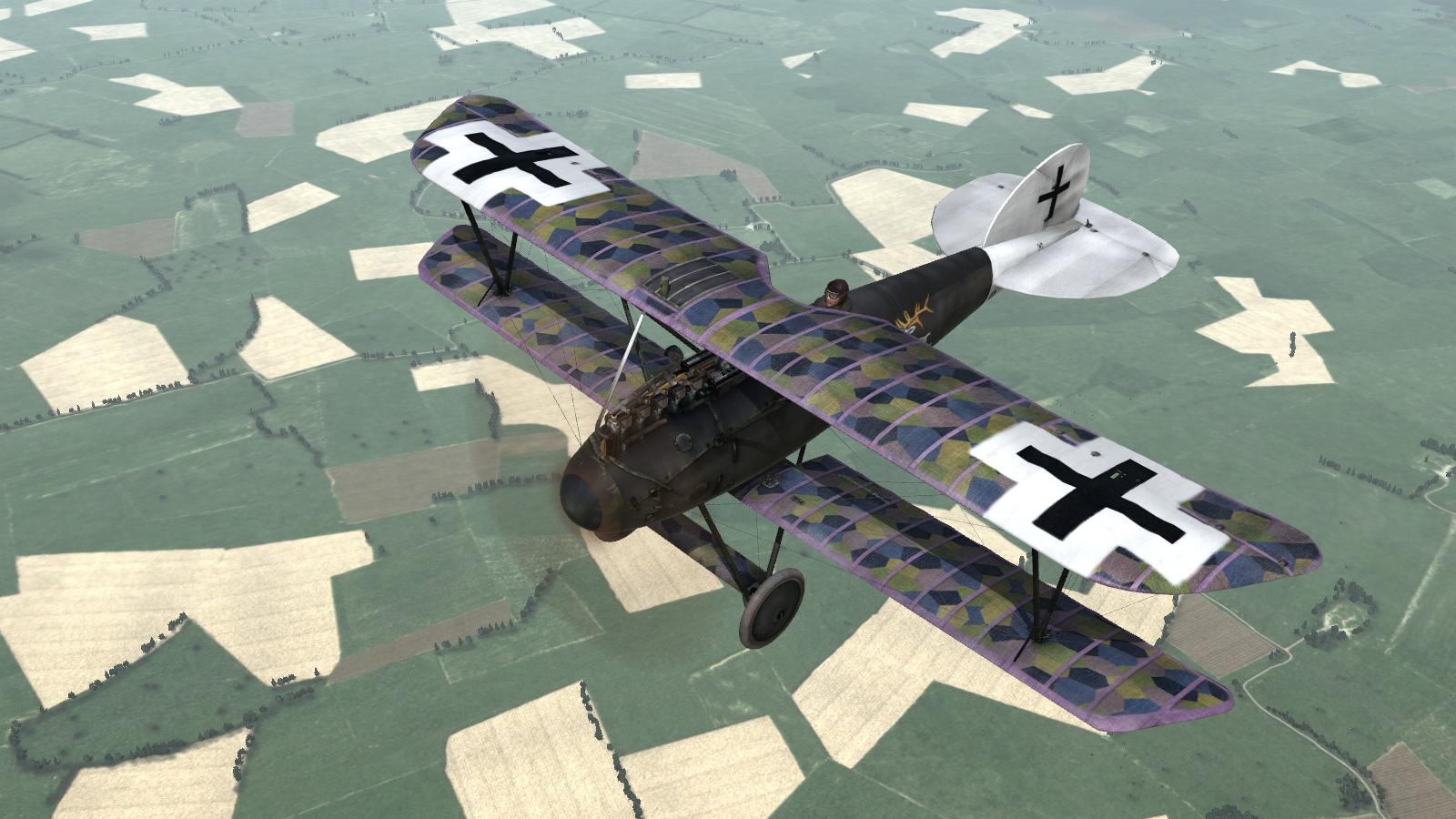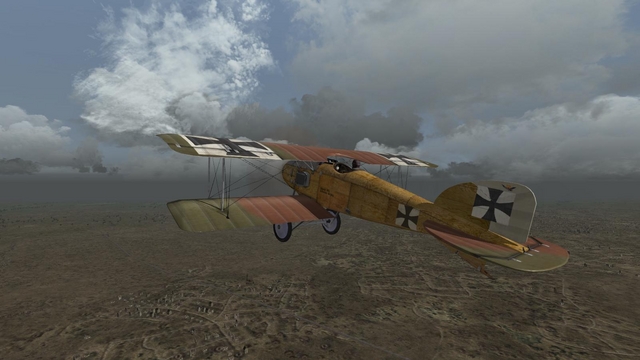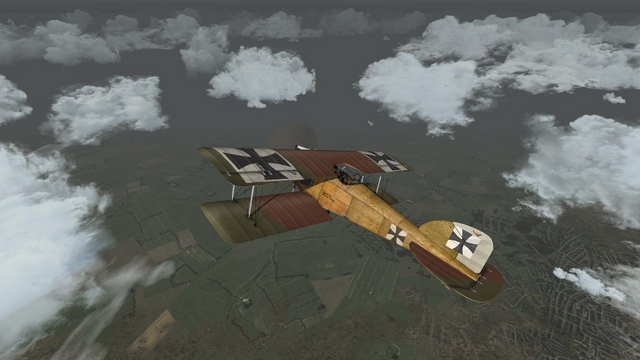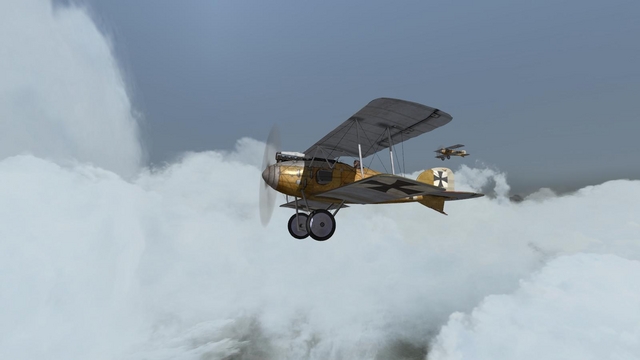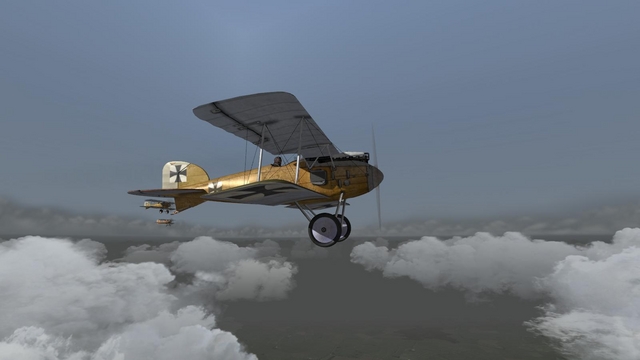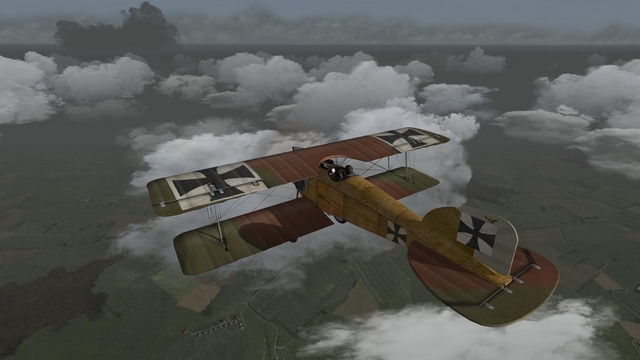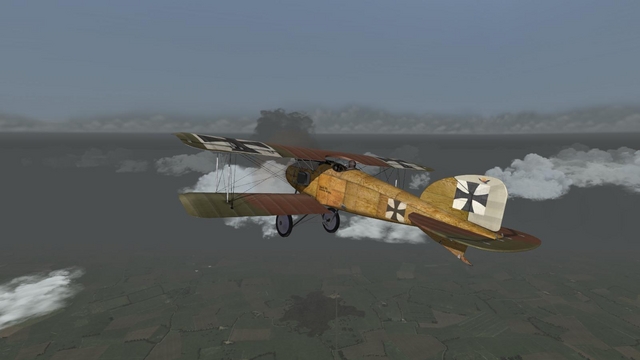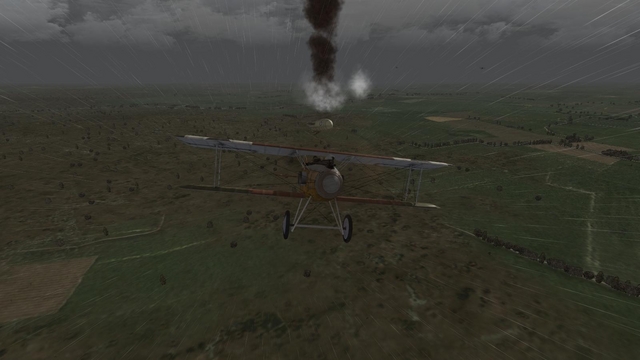Search the Community
Showing results for tags 'wings over flanders fields'.
Found 70 results
-
From the album Combat Sims
-
From the album Combat Sims
-
From the album Combat Sims
-
A mission from my latest pilot career in Wings over Flanders Fields! Having played little but Atlantic Fleet for four solid months since the PC version was released in late February, I recently decided to make a bit of room for some combat flight sim and tanksim action. For the latter, it's back to Steel Fury's indispensible STA mod, and with a bit of luck, I'll soon re-start work on the STA-Britpak sub-mod, having got my hand back in, playing the only mission yet available in the current beta (or maybe it's an alpha) version, featuring the 23rd Hussars in Operation Bluecoat... Doubtless I'll find some time for Steel Armor - Blaze of War also. Its featured theaters of war are more off the beaten tank track that Steel Fury's, but its tanksim-wargame combo really works quite well and it improves on many of the features of the earlier Graviteam tank simulator, specifically in terms of AI, platoon command & control, radio net and target indications. For an air combat fix, I fancy trying out the excellent Blinding Sun campaign in the Combined User Patch mod for Il-2 '46, flying a sleek MiG-3 to defend Mother Russia against the fascist invaders... But before that, it's back to the First Great War in the Air, with the incomparable Wings over Flanders Fields. And what better way to start with a new pilot career in an elite fighter squadron, the illustrious Jasta Boelcke. Formed in the autumn of 1916 as the first fighter unit in the modern sense as Jasta 2, it was re-named for its first commander, pioneer air fighter Oswald Boelcke, after he died following a collision with a fellow pilot's aircraft. Despite this and other setbacks, Jasta Boelcke remained one of the premier German fighter squadrons of the First World War. Naturally, you can sign up with Jasta 2/Jasta Boelcke in Wings over Flanders Fields, at pretty well any time during its wartime service. For me, the most interesting period of WW1 in the air has always been from early to autumn 1917, spanning Bloody April and the subsequent resurgence of the Royal Flying Corps, with the arrival of new fighters like the SE5 and Camel. So I opted to start my career in late March 1917, flying the superb 'V-strutter' Albatros D.III from Proville in Flanders. Even if you haven't upgraded to the latest version of WoFF, with the 'skins' pack now free and the latest version of Ankor's DX9 mod for CFS3 at last enabling us to see off the awful 'fisheye lens' external view, WoFF, its aircraft and its scenery have never, ever looked better. And that includes the white-tailed Albatri of the flight i'm now leading in Jasta Boelcke, as we set out to do battle with the English, over Flanders fields. ...to be continued!
-
Re-living another classic WW1 air war memoir, in Wings over Flanders Fields! This is a rather late addition to my earlier series of WOFF mission reports inspired by real-life WW1 aircrew memoirs. The inspiration in this case is ‘Flying Minnows’ which was, in turn, a late addition to my library, picked up the other week from a local second-hand bookstore. The book was first published in 1935 under the author's pseudonym ‘Roger Vee’, my 1979 reprint appearing under the author’s real name of Vivian Voss. Though sharing the surname of the famous German ace, this Voss was a South African, with family ties to my own home town of Belfast, in Northern Ireland. The man and the book ‘Flying Minnows’ – which I haven’t finished reading yet – begins with Voss’s flying training in 1917, in Canada, having crossed from the USA where he was studying at John Hopkins University, Baltimore, to join up. From his account, the standard of basic training seems only slightly evolved from the beginning of the war. At Camp Mohawk near Deseronto, Voss learns to fly in the ‘Buffalo Curtiss’ type JN-4A, which is what we today would commonly call a Curtiss ’Jenny’. Slightly more advanced training then follows, after a move to Camp Borden, flying both the 'Buffalo Curtiss’ and another ‘Jenny’ they called the 'Canadian Curtiss', with reduced dihedral and a normal joystick instead of the Buffalo's one with a wheel for aileron control. Amongst other things, Voss receives instruction in artillery spotting, providing a usefully detailed description of the basic procedure, including examples of the actual Morse Code signals used. He receives his commission in Toronto then leaves via steamer from Halifax for Liverpool. In England, flying first at Shawbury in Shropshire, Voss records briefly his impressions of other types he flies during ‘continuation training’ there and later. He says of the Avro 504 trainer ‘It took me some time to get used to these rotary engines, and to the extermely sensitive "balanced" rudder. But they were remarkably stable machines and easy to land.' Of the Sopwith 1 1/2 Strutter, he says 'They were easy machines to fly', capable of being trimmed so they could be flown 'hands off' - literally: he tells the story of a Strutter which landed in a field 70 miles behind the Lines, and how the officer who walked over to offer assistance found that '...the petrol tank was empty, but the airmen needed no help. Both the pilot and the observer were dead.' Voss moves to Netherhavon on Salisbury Plain and fears he is doomed to artillery spotting rather than a fighter pilot career, when he hears they have RE8s there. However, he soon finds out he's destined to be flying Bristol Fighters and that these are not the obsolete Bristol Scouts he had known off, but modern 2-seaters, said by some of his fellows there to be '...considered to be the finest fighting machines ever built.' Taking up a BE2e at Netherhavon for the first time, his instruction consists of being told 'Don't spin or loop it, as it won't stand it.' He finds the BE is '...an easy machine to fly, and did several half rolls (Immelmann turns) and vertical banks with it. It was very light and felt like a toy after the the heavier 1 1/2 Strutters I had been flying.' The DH6 trainer also on station is ‘...a very slow machine...hideously ugly...commonly known as a 'Clutching Hand' or a 'Crab'. I have seen Crabs flying against the wind with such low air-speeds that they were actually drifting backwards relative to the ground.' Of the RE8 he says 'It was the heaviest machine I had yet flown...fortunately all the serviceable RE8s were crashed just about this time, so I was put straight on to Bristol Fighters.' Of his first solo in the latter machine, Voss says 'I felt at home at once...the engine, a 250 hp Rolls- Royce, was infinitely more powerful than anything I had come acrross so far. It gave a full-throated roar and shot away across the aerodrome and then up, soaring into the air like a great eagle. She was a massive machine but so beautifully designed that she did not feel heavy on the controls. She responded surperbly to the least touch of the stick or rudder-bar.' Such are the impressions that we WW1 air war afficionados love to savour! Voss's most memorable experience from this time is when he’s sent on an ‘altitude test’ to confirm he can tolerate the conditions. This he manages, but his base is clouded in below him. Having without visible reference points drifted well south in his wide spiralling ascent, he ends up coming back down through the overcast to find himself well out over a blustery sea, land no-where in sight. Luckily, he runs out of petrol close to a solitary fishing boat, which quickly rescues him. Completing his training, Voss is posted to France and is on operations from February 1918 to the end of the war, flying first with No. 48 Squadron, then with 88. With the reticence that was typical of the times, the squadrons are not identified by number and individuals are identified by more pseudonyms; but all is revealed in detailed appendices by renowned WW1 author Norman Franks, which include lists of casualties and claims for both squadrons during the author’s period of service. I haven’t done more than skip through the rest of the story but from what I’ve seen, it’s a fascinating one, different from but well up there with the likes of Norman MacMillan’s ‘Into The Blue’ or Duncan Grinnell-Milne’s ‘Wind in the Wires’. Based largely on an incident during training, one online review unfairly slates Voss for being a ‘chinless wonder’ type of officer, looking down his nose at the ‘other ranks’ - but leaving aside the fact the review mis-reports or mis-represents the incident, Voss is a man of his times not ours. And a brave man at that. To me, he displays a real charm and a self-effacing sense of humour. He does not disguise his fears, while maintaining the usual (for that era and that author base) stoical stance when recounting some of the crashes and other nastiness he encounters. I’ll not spoil the book for anyone else by saying more...besides, I haven’t finished it myself, yet! But it has already prompted me to start another Bristol Fighter campaign – I think my last serious one of these was in Over Flanders Fields, WOFF’s predecessor, so this outing in the Bristol is long overdue. The campaign Though Voss’s war started in early 1918, my favoured period for WW1 in the air is 1917, taking in ‘Bloody April', the RFC’s subsequent resurgence, and the appearance of many classic types like the Albatros D.III and D.V, the Pfalz D.III and Fokker Dr.1, and on the Entente side, the SE5 and the Camel...and of course, the Bristol Fighter. I decided to start in March 1917, with the type’s debut at the front with 48 Squadron. A side-benefit of this is that my low-spec PC isn’t going to be over-taxed by the higher volumes of air activity generated by WOFF for later-war periods, or need me to dial back my graphics settings. At this point, we have the early F2A version (tho WOFF visually represents this with a typical, later F2B). And our ranks include as a flight leader no less a man that William Leefe Robinson VC, feted back home as the slayer of a ‘zepp’ raiding England, in fact not a Zeppelin but the Schutte-Lanz airship S L11. Sure enough, WOFF’s order or battle lets me not only fly with the same squadron Voss was to join, but from its inauguration at the front and with Leefe Robinson on its duty roster. And of course WOFF puts us where we should be, at the airfield of la Bellevue. Naturally, I’m hoping that's as far as the recreation of history goes - because I want to avoid the fate of the squadron in what was reported to be its first foray over the Lines into enemy airspace (termed an 'Offensive Patrol', which Voss reminds us was known at the time as a 'O Pip'), when it met Manfred von Richthofen’s Jasta 11 and lost four out of six, including Leefe Robinson’s Bristol. The first mission As befits our first excursion since arriving at the front, our opening mission is a trip up to, but not over, the Lines. Having no particular interest in formation flying and preferring the extra tactical challenge of the flight leader, I have selected ‘Always lead’ so I’m at the head of the four Bristols for this trip. Bad weather – WOFF’s option to replicate the effects of historical weather, is another feature of this truly great sim – 'washed out' the previous day’s flying, so I’m keen to get away and at the Hun. I check the controls and start her up, the others doing likewise, including ‘A’ Flight, which will have three machines operating in loose support in the same area. I open her up and off we go! The ground is soon falling away behind us and I’m relishing the powerful, low snarl of my big Rolls Royce engine, such sounds being another of WOFF’s outstanding features. Up ahead, there’s still a lot of cloud, and if we go for our briefed altitude of 7,500 feet, I’m not yet sure whether we’ll be below, above or amongst all the white stuff. I’ll worry about that when I get up there, I decide. At a couple of thousand feet, I throttle back and level off while the others catch up. We make a series of gentle climbing turns, opening up and climbing harder as the formation comes nicely together. ‘A’ Flight slides across behind and below us and is last seen as a group of three dark specs, to our left and somewhat lower down. As we gain height, I settle onto a course that will take us to our assigned turning point above, but not across, the famous Lines. Grey and white clouds gather all around, but we plough on. The cloud stays fairly well broken and visibility is acceptable at our patrol height, which we reach after a long climb. With no ‘warp to next waypoint’ feature in WOFF, I much prefer to fly in real time. Even with autopilot, I dislike flying in accelerated time, but the short flights make this bearable. This, and the fact that if there’s a sim besides WOFF which captures with such uncanny depth the feeling you get from so many accounts of flying over the front in the First World War, I have yet to find it. Even over my own side of the Lines, with contact with the enemy not especially likely and with enemy fighters less so, I was kept busy enough scanning the skies above, around and below, in between admiring the view. And there is much to admire. For one thing, the Bristol, always one of the best-rendered kites in OFF, looks better than ever, in WOFF. As does the landscape, in this case including the battered town of Arras, near the Lines below us and soon to give its name to the battle that will spawn 'Bloody April'. The cloudscapes are equally good (especially with Arisfuser's cloud mod). They're not volumetric and sometimes it shows; but to my eye, they are as good or better than anything else in the business and their presence and appearance adds massively to the feeling that 'you are up there', over the front and at the mercy of everything from the elements, to the Archie (AA fire) and of course, the wily Huns, in the sun and elsewhere. But on we go, the eight of us, pilots and gunners, in our big new Bristol Fighters, ready for anything...we hope... ...to be continued!
- 5 replies
-
- f2b
- wings over flanders fields
-
(and 3 more)
Tagged with:
-

Wings over Flanders Fields - Pfalz D.IIIa, Jasta 18
33LIMA posted a gallery image in Member's Albums
From the album WOFF
-

Wings over Flanders Fields, Albatros D.II, Jasta 2 campaign: a BE2c goes down
33LIMA posted a gallery image in Member's Albums
From the album WOFF
-
- wings over flanders fields
- albatros d.ii
-
(and 1 more)
Tagged with:
-

Wings over Flanders Fields - a Jasta 2 Albatros D.II over a ruined town at the lines, October 1916
33LIMA posted a gallery image in Member's Albums
From the album WOFF
-

Wings over Flanders Fields - Jasta 2 campaign, October 1916 - Aviatiks are safe, we're now hunting RFC FE2bs
33LIMA posted a gallery image in Member's Albums
From the album WOFF
-

Wings over Flanders Fields - Jasta 2 campaign, October 1916 - en route to the RV with the Aviatiks
33LIMA posted a gallery image in Member's Albums
From the album WOFF
-

Wings over Flanders Fields - Jasta 2 campaign, October 1916 - Aviatiks under escort -2
33LIMA posted a gallery image in Member's Albums
From the album WOFF
-

Wings over Flanders Fields - Jasta 2 campaign, October 1916 - Aviatiks under escort
33LIMA posted a gallery image in Member's Albums
From the album WOFF
-

Albatros D.II, Jasta 2 campaign, Wings over Flanders Fields
33LIMA posted a gallery image in Member's Albums
From the album WOFF
-

Albatros D.II, Jasta 2 campaign, Wings over Flanders Fields
33LIMA posted a gallery image in Member's Albums
From the album WOFF
-

Albatros D.II, Jasta 2 campaign, Wings over Flanders Fields
33LIMA posted a gallery image in Member's Albums
From the album WOFF
-

Albatros D.IIs escorting Aviatiks, Jasta 2 campaign, Wings over Flanders Fields
33LIMA posted a gallery image in Member's Albums
From the album WOFF
-

Albatros D.II, Jasta 2 campaign, Wings over Flanders Fields
33LIMA posted a gallery image in Member's Albums
From the album WOFF
-

Albatros D.II downs an observation balloon, Jasta 2 campaign, Wings over Flanders Fields
33LIMA posted a gallery image in Member's Albums
From the album WOFF
-

Albatros D.II, Jasta 2 campaign, Wings over Flanders Fields
33LIMA posted a gallery image in Member's Albums
From the album WOFF
-
- albatros d.ii
- woff
-
(and 1 more)
Tagged with:
-
Second time lucky? Flying the BE12 in Wings over Flanders Fields This time up, having met a heroic but early end in my First Eagles BE12 campaign, I'm checking out the same experience in WOFF. No need to worry about editing files this time tho, for the BE12 is one of the new planes included in this latest version of OBD Software's popular WW1 airwar sim. 'Latest' not for long, though, as a new iteration, WOFF 2.0, is about to hit the virtual shelves, as a payware upgrade and expansion, with the emphasis on Home Defence against Zepps and Gothas: http://simhq.com/forum/ubbthreads.php/topics/4018110/WOFF_v2.0_Screen_Shots__!#Post4018110 As in FE, I created a new pilot, finding that I could enlist in the same squadron from the same date - 19 Squadron, RFC, from 1st September 1916, just days before Boelcke and his 'cubs' from Jasta 2 burst onto the scene. WOFF bases us at Fienvillers/Candas, to the north-west of Cappy and further behind the Lines, than in FE. And here's my pilot logbook, a much better presentation than FE's pilot stats screen (better than how most other combat flight sims have done this, come to think of it). Not so good is the accuracy of this page, describing my mount, which emphasises the BE12's brief and almost accidental fighter role and says it was at the front in April 1915, a whole year or more too early. The data in the panel looks more like it applies to the BE2c; for example the BE12 has a 150hp RAF4 engine, not a 90hp RAF1 and the armament is also wrong. Here's the squadron roster for my first campaign mission. Perhaps WOFF is trying to break me in gently with a patrol behind my own lines. And while I've selected 'always lead', I'm leading just myself, for oddly, I'm on my own in B Flight while A Flight is well up to strength, and flying top cover, for just little old me. Obviously, this squadron believes very strongly in looking after its new pilots. Naturally, I did not consider for a moment the possibility that they might be using me as bait for the wily Huns. And here's the briefing itself, confirming this rather odd arrangement: No doubt, the CO knows best. Ours not to reason why, and all that. Off to the airfield I went, finding myself lined up next to A Flight. Losing no time, I started up, checked the controls and as soon as the others began to move off, opened her up. The WOFF BE12 is not a bad replica, tho the nose is I think a little slender. Unfortunately it has not yet been updated like the WOFF BE2c and thus still has its interplane struts visibly too far inboard. Hopefully WOFF 2.0 will effect some improvement. With little thought for such things, I banked around and turned my mind to the task at hand: to wit, a solo patrol behind our own trench lines, with A Flight covering me from somewhere on high. Nothing to it. Or so I thought... ...to be continued!
- 3 replies
-
- woff
- wings over flanders fields
-
(and 1 more)
Tagged with:
-
Jasta 5 at Cambrai - a 'Wings Over Flanders Fields' Campaign The first mission - 20 November 1917 A little while back, CA member Captain McMuffin suggested I report on the progress of a campaign or two. Seems like a good idea to me, so here's the first installment of the first campaign. If there's interest, I expect I'll feature different sims; but first up, it's back to the new kid on the WW1 block, Wings Over Flanders Fields. My chosen unit for this campaign is Jagdstaffel 5, famous both for its Albatrosses' green-painted tails and as the unit of the 'Golden Triumvirate', the three famous NCO aces Rumey, Mai and Koennecke. It's also the unit of Leutnant Hans von Hippel, whose green-tailed Albatros DV with its prominent dragon marking (apparently borrowed from another pilot) was famously photographed after a lower wing broke off at altitude and the pilot was lucky to get down in one piece. It's late November 1917, the first day of a big British offensive, spearheaded by a large force of tanks. It looks like fate has picked an interesting time for me to arrive at the front! A rookie Leutnant on my first assignment to a combat unit, I'm glad to have been posted to a staffel with a decent reputation and some outstanding pilots - Jasta 5. We're based at Boistrancourt, near the town of Cambrai itself, right in the path of the new British offensive, although we pilots don't know this yet. Our aircraft is the Albatros D V, the latest version of this sleek fighting machine, but by now, we all know its abilities are falling behind those of the latest enemy aircraft. And the lower wing troubles which first appeared with the D III model in early 1917 appear to have resurfaced. But in the hands of a good pilot it can hold its own and until better aircraft arrive from German factories, we must make do with what we have, At least the flight I'll be with on my first mission is a good crowd, experienced pilots with a fine tally of victories between them. In fact the top scorer, Sikorski, has been detailed to fly on my wing, no doubt to keep a close eye on me and make sure I don't do anything silly...and also that I get home in one piece, I hope. The day of my first combat flight has arrived! It's early morning and six of us have been detailed to patrol near Cambrai at about two thousand metres. I'll be flying in the leading 'vic', on the left of our leader, Hauptmann Bonin. Fortunately, the weather is good. In my excitement I have neglected to check the intelligence reports but I know that we can expect to face the enemy's best and that both French and British aircraft could be operating in our sector. As they fly offensively, I know that we can expect to meet them from the moment we are airborne. On the grass at Boistrancourt in front of our canvas hangars, our lined-up aircraft make a fine sight, with their varnished plywood fuselages gleaming softly and our red-edged green tails proudly proclaiming our Jasta's identity. What will my first mission bring? It's time to find out! ...to be continued!
- 4 replies
-
- 1
-

-
- jasta 5
- wings over flanders fields
-
(and 1 more)
Tagged with:
-
Spotting for the Gunners in the LFG Roland C II! In an air war notable for the sheer variety of planes of all shapes and sizes that made it to the front, the LFG Roland C II must be one of the most distinctive, if not also one of the most attractive. 'Truely, this aircraft is a whale!' was the reaction of one of the German procurement people who came to see what they'd be getting for their reichsmarks, giving the Walfisch its enduring nick-name. But it was also one of the most advanced aircraft of its day, a compact, fast, streamlined single-bay two-seater general purpose aeroplane in a world where other such machines were bigger, slower or ungainlier…and mostly, all three. 'The best German aircraft now' was reportedly the verdict of RFC ace Albert Ball, who frequently came up against (and shot down) the type in the summer and early autumn of 1916. However, though sometimes encountered in sizeable formations in this its heyday, the Roland was produced in comparatively small numbers and its front-line service career was over by about mid-1917. Speedy in the air, it was slow and expensive to make. Its thin wings tended to warp in the harsh conditions of front-line airfields and visibility for landing was poor, resulting in many crashes or hard landings. But still, it was a notable performer for its time, whose capabilities generally matched its good looks. Many of us will know the type from the 1960s Airfix 1/72 kit, helpfully moulded in light blue plastic in imitation of the distinctive finish initially carried by the Roland. It made up into a nice model, with decent crew figures instead of the dreaded 'goggled alien' of earlier Airfix WW1 kits. One day, I will make this kit again, notwithstanding that newer versions are available. In the meantime, I can fly the Roland in simulators. I don't yet have the Rise of Flight Roland, seen here escorting my DFW C V in a recent mission... ...but I do have and like the First Eagles versions from the A Team Skunkworks. Though they have a 'Spandau' machine gun for the observer, instead of a 'Parabellum', there are a couple of interesting variants, including this one with a captured Lewis Gun fitted to fire ahead over the propeller arc, which was tried in real life: But for this mission I chose Wings Over Flanders Fields. Having flown the Roland in Over Flanders Fields, I was keen to see how I made out with this machine in the latest incarnation of this sim, with Ankor's self-shadowing mod and the new AI and landscapes of WOFF. The campaign Creating a new pilot, I tabbed throught the available German 'Bomber/recce' squadrons flying in September 1916 till I found one that flew the Roland in the British sector - WOFF still provides a better representation of the RFC order of battle, and would benefit in particular from the addition of French two-seaters more suitable for either 1916 or 1918 than the Morane L (really a 1914-15 type) and the licence-built Strutter (gone from the front by mid-1918). I ended up with Feldflieger Abteilung (Artillerie) 240, based at in Flanders. I believe the 'Artillerie' indicates that we specialise in observing for the artillery and can correct their fire using radio transmitters, one of the major jobs for two-seaters in WW1, along with photo or visual reconnaisance and to a lesser extent, bombing. Here's our roster and our operational area. Even without tabbing to the Intelligence summary, I knew that the deadliest foes we could expect to face in our sector would be DH-2 'pusher' fighters and the more modern French Nieuport scout, both types used by several RFC squadrons. With the British fighters apt to patrol up to ten to twelve miles on the German side of the Lines, I knew also that we must be prepared to meet them in the air, whatever our task would be. The mission It's 12 September 1916, and our assigned task for this morning is artillery observation. Down to the south west we must go, from our airfield at Houplin down to the trench-lines. There are no less of six of us on this operation, with myself leading the full flying strength of the staffel. When I draw an 'art obs' mission in OFF or WOFF, I generally fly to the front and orbit near any friendly artillery barrage in progress, as if I was directing the fire. It's not possible actually to call down fire onto ground targets (although after this mission I'm no longer so sure, of which, more later). If there's no artillery fire going on, I regard my radio transmitter (or the battery's receiver) as having 'gone dark' and do a bit of recce work, so that the taxpayers still get their money's worth. We have an escort, but I wasn't going to put much faith in the two obsolete Fokker Eindekkers we'd been allocated. For all I knew they were the last ones at the Front, still able to beat up a BE2c but well outclassed by any fighter we were likely to meet. My own flight would serve as my escort. I would do the virtual artillery-spotting. Knowing that formation-keeping in WOFF was considerably improved over OFF, I knew my comrades would be able to keep up quite well as I circled over the front. Anyone trying to shoot down the spotter - me - would have to get through them, first. At least, that was the theory. Here we are, lined up opposite the sheds and ready for the 'off'. I had chosen a camouflaged skin from those available in WOFF, but the rest of the flight are in the original, distinctive and rather racy light blue. I checked my controls and started up. Then I called up the Tactical Display (TAC), set its target type to 'aircraft', checked its range was suitably low (I left it at half a mile) and turned the TAC off again: it was now ready to padlock air targets, when turned on again. I didn't expect to do too much (if any) dog-fighting on this mission but if I had to break formation and fight individually, I decided I was going to make good use of my forward-firing MG, relying on the observer to cover my tail. Which is more or less how it came to pass. But that lay in the furture. I roared off the airfield and tried some gentle turns before setting course for the Front and throttling back to allow my flight to catch up. I found the ailerons deceptively light and the rudder heavy. It was easy to under-bank and slip outwards, or worse still, over-bank and find yourself in a nasty side-slip, if you didn't give her plenty of top or bottom rudder. This was nearly to be my undoing. But that, too, lay in the future. For now, I watched my flight catch up from astern. One of them took several minutes, during which time I saw two aircraft fly past overhead - the two Fokkers, I supposed. This was the only time I saw them, as it turned out. At at last we were all in a nice diamond formation. I opened the throttle wide and I began to climb, maintaining forward pressure on the stick to stop my tail heavy plane's nose from rising too much. All around us, thin clouds loomed, slipped past below, beneath or beside us, then loomed ahead again. I spent a little time admiring and exploring my plane, inside and out, between navigating and scanning the skies. Visibility downwards was, as expected, not good, but in every other direction, I had a superb view, unobstructed by the usual high-mounted biplane upper wing. Looking behind, the sight of my flight tucked in behind me inspired confidence…to much, perhaps, I thought, remembering Albert Ball's opinion that such formations were easier to surprise as the aircrew tended to feel a false sense of security and relax. On we went. Climb rate was less than stellar and we were not far above five thousand feet as we came up the the trench-lines. Our Fokker escorts were nowhere to be seen and I decided I wasn't going to hang about looking for them. I was at a respectable height for artillery observation and was now at the Front, where lay our targets. I leveled off and throttled back slightly. I had arrived at the war. Approaching the area over the Lines where we were tasked with spotting for the Gunners, I turned on the Tactical Display to get a navigation check. Instead, I got a surprise. In fact, I got two surprises. First, knowing that I was headed roughly in the direction of my target area, I was startled to notice that the pale blue line showing the path to my next waypoint, instead of pointing up, straight ahead, had slewed around to my left rear. If that wasn't strange enough, the text displayed beneath the TAC itself was telling me that it was high time to go home. In fact, not even home - to the nearest airfield. Had I inadvertently skipped a waypoint? No, I was fairly sure I had done no such thing. My true objective still lay ahead. Who's leading this mission, anyway - me or the Tactical Display? Pilots in the German Air Service may often be mere NCOs but while I may have to take orders from my commissioned observer - my own alter ego, anyway - I'm certainly not at the beck and call of an on-screen visual aid. Sod that, I thought. On we go. Actually, the TAC was trying to be helpful. Looking behind, the reason for the device's caution was not hard to see. An aircraft was slicing into our formation from our left rear. And though I didn't notice it at the time, three other aircraft were below and behind us to the right. My initial reaction, seeing just the one presumed enemy attacking, was that I'm not going to break formation and get distracted from my objective for the sake of one aggressive Englishman. Unfortunately, those on the right of my formation didn't agree that staying together and meeting the enemy with massed fires was the best bet. That side of my formation broke up rapidly, as Rolands wheeled off and after the Nieuport. All very commendable perhaps and it certainly seemed to put off the foe-man, who turned away. I now had a decision to make, and I needed to make it immediately, before the passage of time removed one of my options. I could hold my course to the objective, with what looked to be two remaining flight-mates. Or I could turn us back to join the battle, keeping my formation, if not intact, then together; and resuming my progress to the objective when the battle had been won. Keeping to my present course seemed to comply with the Master Principle of War - Selection and Maintenance of the Aim...but at the expense of one nearly as important - Concentration of Force. Incidentally, contrary to what John Keegan said in 'The Face of Battle', these principles, far from being thought old-fashioned, were taught at Sandhurst in the late 1970s. Anyhow I had read too many accounts - Trafalgar, for one - of forces that are (or get) split up, then being defeated in detail, even by numerically weaker enemies. So I turned back to join the fight. By this point I had realised there was more than one enemy aircraft. I picked up one who lay ahead and gave the attack order, so that the others would pick their own targets. Mine, I recognised as a Nieuport Scout. He was manouevring a few hundred feet below, to my half-right. I made a series of swooping attacks on him, allowing my observer a crack as I whizzed past. While I kept up my speed and most of my height, the tightly-turning Nieuport was able to turn in under my attacks most of the time. He in his turn was prevented from having a determined go at me by the presence nearby of at least one other Roland. After a few more passes I got behind him and stayed there long enough to get in several good bursts from not too far out. He stopped manoeuvring and settled into a steady glide earthwards, emitting a spluttering trail of grey smoke. I watched as he piled up into the mud behind me. Got him! But the fight wasn't over yet! ...to be continued!
- 4 replies
-
- roland c ii
- woff
-
(and 1 more)
Tagged with:
-
The other nationalities in Wings Over Flanders Fields Part 2 - the US Army Air Service The plane For this WOFF campaign mission with the US Army Air Service, I should perhaps have chosen the SPAD XIII, instead of 'yet another Nieuport'. But this Nieuport is different. For starters, the Nieu.28 has been one of my personal favourites, from the mid-1960s when I built Revell's little 1/72 kit in their new range of WW1 fighters, great models for their day, with classic Brian Knight box art. And while the 28 retained the rotary engine of its predecessors, it replaced the weak single spar lower wing and V-struts with a more conventional, but no less elegant, wing structure. The aircraft may have been infamous for shedding the plywood leading edge of the upper wing and attached fabric on pulling out from a power dive. Sometimes, unburnt petrol collected in the engine cowl went on fire. But apparently, unlike the lower wing failures of the V-strutted Nieuports, these issues, though alarming, were rarely if ever fatal. And the Nieu.28 was fast, agile and fairly reliable - certainly more so than the SPAD XIIIs which replaced them, the geared Hispano-Suiza engine proving so unreliable that French units equipped with the XIII reportedly kept a stock of SPAD VIIs to maintain flying strength. Besides, I had previously flown a series of comparative mission reports featuring the Nieu.28 in First Eagles 2, Rise of Flight, Over Flanders Fields and IL-2 Dark Blue World 1916 (here). So with WOFF having supplanted OFF, this mission report serves nicely, if I may say so, to bring that series up-to-date. The unit I elected to fly with the first unit to receive the Nieuport 28, the 95th Pursuit Squadron, the 'Kicking Mules'. Held back for additional gunnery training, the unit wasn't in action until the beginning of May 1918, by which time fellow First Pursuit Group unit the 94th 'Hat in the Ring' Pursuit had already seen some action. Here's the WOFF squadron board for the 95th; many of the named pilots are recognisably those who really flew with the squadron at this time. We are based at Toul, not far from the shattered battlefield of Verdun, scene of one of the war's most awful battles, during 1916, when the French army fought the Germans to a standstill in a desperate and costly but successful defensive effort. Two years later the front here is relatively quiet, although further north in the British sector, the Germans have unleashed their spring offensive in a last-gasp effort to turn the tide and win the war in the west. The mission Here's the mission briefing. We're putting up two flights as escort to a reconnaisance by three French Sopwith 1 1/2 Strutters from Escadrille Sop 43, flying down from Beauzee sur Aire. This type was already obsolescent when the French started using it in large numbers during 1917, to replace even older 'pusher' types. At this point in the war, the French Strutters were in the course of being replaced themselves, generally by the excellent Breguet 14. Here were are lined up and good to go. I'm flying with a single flight-mate, with the squadron's other flight on 'top cover'. I have chosen the 'skin' of Lt Quentin Roosevelt, the President's son, who had the dubious distinction of being pictured on German postcards lying dead and broken beside his crashed Nieuport, after being shot down in July. If this is one of the 'skins' I've copied over from OFF, it works fine; the long grey fillet atop the rear fuselage is not a glitch, it was on the real aircraft. After take-off I took it easy until my number two had caught up, then sped off to the rendez-vous point with the two-seaters, climbing hard. The skies were an unbroken blue, visibility good but hazy at longer range. It wasn't long before I spotted them; three Strutters with the distinctive French roundels, all in un-camouflaged clear doped linen finish, which made them relatively easy to see from above, against the ground. By this time I had lost sight of the squadron's other flight but trusted they would be up and behind us, somewhere. In turn, I took my own station above and behind the Sopwiths, weaving left and right to keep station while maintaining my airspeed. Our route was a long slanting one which took us back and forward over the zig-zagging front lines. All seemed peaceful, until I heard from somewhere close by, above the noise of my own motor, the sound of an aero-engine revving and stuttering. Looking back, the cause was not hard to see. My flight-mate's engine was on fire! There had been some Archie fire earlier but the skies were now clear of both AA bursts and enemy aircraft. So I took this to be one of the random failures WOFF simulates (unless you have it turned off) - perhaps one of those fires from pooling petrol in the cowling. Despite the dark smoke and the pyrotechnics, my buddy seemed under control, and quickly turned back towards friendly territory. Though I was relieved at the prospect my flight-mate would get away with it, I was rather less happy at the thought of a long solo escort flight. Suddenly, I felt very lonely. I'd have felt a whole lot happier if I could have seen the other flight of Nieuports, but wherever they were, they were invisible to me. Nothing else for it. I flew on, zig-zagging behind and above the three Sopwiths, varying my turning points and keeping an even more careful look-out. But the skies around us remained clear, apart from some intermittent Archie. The German gunners must have fancied a challenge, for instead of targeting the straight-flying two-seaters, when they did cut loose, it generally seemed to be at my Nieuport. This did no damage but it certainly made me feel all the more exposed and vulnerable. The flight stretched on interminably. Whether it's Silent Hunter 2/SH3 or IL-2, I've never much liked time compression. The 'warp' feature of CFS/CFS2 I did like, though not quite so well when in CFS3 it changed to very rapid time acceleration. At least it dropped you out if enemies were near, which WOFF's current time acceleration 'warp replacement' does not. Best of all is the 'next encounter' facility in European Air War and Strike Fighters/First Eagles. But without it auto-quitting when contact was imminent, and especially up on my own, I was reluctant to speed things up. I flew on in real time. The tension left little room for boredom! Nearing their turning point for home, the Sopwiths flew past two of Verdun's large forts, both set in the sea of shell-cratered mud that stretched all around and as far as Verdun itself to the south-west. I urged them on. Since my flight-mate's departure, any desire on my part for a fight with the Boche had evaporated. My sole concern now was to see my charges as far as their objective, watch them make that turn for home, then see them safely over the lines. And then get myself home in one piece. Victory claims and medals could wait for another day! Finally, the Sopwiths turned left and headed back towards friendly territory, just a short distance to the south. I turned with them. The mission had ended uneventfully, but I had no regrets. The relief of the anxiety I'd felt since losing my flight-mate was palpable. The satisfaction of a mission accomplished more than made up for the lack of air combat. I'd got my charges back safely! But not quite. Looking back not a moment too soon, I was appalled to see at least three Albatros scouts with candy-striped tails breaking formation and peeling off to attack. Worse if anything, they looked to be after my Sopwiths! Groaning at being so nearly home free and now having to fight at bay and badly outnumbered, I nosed down and around, and cut them off. An aggressive defence seemed the best policy. At any rate, they were not going to get my Sopwiths! Get stuck into them, give them plenty to keep themselves occupied, then dive for home at the first opportunity. And I would do my level best to get one of the Boche first, if I possibly could. This seemed to work quite well. The enemy pilots appeared to forget about the Strutters, evidently intent on shooting me down first. I was soon in the middle of a stiff little dogfight with the three Albatros scouts, hurling my machine about the sky, taking snap-shots each time an Albatros sailed across my path. Likewise, the Boche were taking shots at me, whenever they got the chance. I tried to edge the fight towards my own side of the Lines, ready to dive away for safety when the right moment came. But it never did. Instead, there was a horrible rending and ripping sound as the top left wing of my evidently over-stressed aircraft tore off! Down she went, straight down. I throttled back but the flight controls seemed not to be answering. The end came suddenly, inevitably. To add insult to injury, what I was quite certain was a structural failure was credited to enemy action; either way one of the Boche will doubtless be putting in a claim for ein Amerikaner kaput. Given that the real-life Nieuport 28's structural issues seemed to have killed few if any pilots, I was a little miffed that my tenacity and at the end, my rather courageous solo defence of the Sopwiths should end thus. I hope mes camarades Francais in the two-seaters will carry with them back to their base a suitably glowing account of the brave end of the pilote Américain courageux who saw them safely home at the expense of his own virtual life. Perhaps a posthumous Légion d'Honneur will be in order?
- 4 replies
-
- 1
-

-
- nieuport 28
- wings over flanders fields
-
(and 1 more)
Tagged with:
-
The other nationalities in Wings Over Flanders Fields Part 1 - the French air service I can't do a biography-based mission report for the US and French sides as I only have memoirs by British and German pilots. But for the sake of completeness, I'm going to do a separate pair of mission reports in Wings Over Flanders Fields, one flying for the Aéronautique Militaire, the other for the US Army Air Service. First up, it's the French service, flying the little Nieuport 11, aptly nicknamed the bébé (baby). The plane Oddly enough, pre-war Nieuport designs were monoplanes. Their first biplane was the two-seat Nieuport 10 of 1915, which set the pattern for the aircraft which were to follow: biplanes with a much smaller lower wing, joined to the upper one with a V-shaped interplane strut. These were intended from the start to be armed. The early Nieuport 10 AV had the observer in front ('en avant', hence AV) with a circular cut-out in the upper wing, to enable him to stand up and fire a carbine or a Hotchkiss machine-gun pintle-mounted on the wing in front. But the later Nieuport 10 AR, and the more powerful Nieuport 12 which followed, moved the observer to the rear ('en arriere', hence AR) where he manned a Lewis Gun on a moveable or rotating mount. The Nieuport 10 AV During 1915, some Nieuport 10s were flown as fighters on patrols, with a Lewis Gun fixed above the upper wing to fire ahead, high enough to miss the propeller arc. Their success inspired the Nieuport 11, a smaller, nimbler development. This was arguably the first real fighter aircraft; genuinely capable of air-to-air combat in a way the inferior Fokker monoplanes were not - the latter being interceptors rather than fighters, with a synchronised gun but primitive wing-warping roll control and generally not well-suited to dog-fighting. In the hands of France's emerging aces like Georges Guynemer and Jean Navarre, the Nieuport 11 was instrumental by early 1916 in reversing the German's brief period of ascendancy in the air, 'the Fokker Scourge'. The British contribution was the DH-2, but while also better than the Fokker, this 'pusher' design was a technological blind alley. By contrast the Nieuport 11 proved capable of significant further development. Later versions, the Nieuport 16, 17, 23, 24 and 27, were widely used by both French and British, and later by the US Escadrille Layfayette. RFC aces like Albert Ball and Billy Bishop also rose to prominence flying Nieuport Scouts. The type was widely used by Italian and Russian air forces as well as on the Western Front, despite a continuing and alarming tendency to failures of the weak lower wing, often killing the pilot. All in all, the Nieuport V-strutters were one of the war's classic designs, inspiring the layout of the German Albatros D III which from early 1917, largely swung the air superiority pendulum back towards the Germans. Recommended reading on Nieuport aircraft would include Crowood's 'Nieuport Aircraft of WW1' by Ray Sanger and Osprey's 'Nieuport Aces of WW1' by Norman Franks. The unit For this mission, I created a new French pilot and assigned him to Escadrille N.12 (the French gave squadron numbers a leading alphabetic designator which - though a change could sometimes lag behind a change of aircraft - indicated the principal type of aircraft flown - 'N' for Nieuport, Spa for SPAD, for example). The unit had a long and worthy combat history. There's a great online source here; even if you speak no French, the illustrations, maps and tabular information tell their own story. The unit marking was a blue and while 'fanion' or guidon with the number '12', usually in red, carried on the side of the fuselage. As you can see, it's 1 May 1916 and we are based at La Cense, near Compiegne. Happily, we are close enough to La Belle Paris for us to have some interesting and diverting 'R and R', on our days off. But that's a very different kind of mission with quite distinct objectives! The mission Here's the brief for today's mission, which takes us well away from the delights of Paris. It's a patrol along a dog-leg route, up to the trench lines, which are not too far away. I'm leading a flight of three; a second flight of two aircraft is also flying the mission, as 'top cover'. Our briefed mission height is 10,000 feet. Starting on the grass in front of the sheds at La Cense, I waited till the first couple of machines had roared off then sped after them. All of us were in green and brown 'shadow shading' camouflage, apart from one fellow who was in clear doped linen, with prominent blue, white and red chevrons on his fuselage. This was the aircraft of squadron ace Lt Pierre Dufaur de Gavardine, said in the Osprey aces book to have scored six victories with the unit, before being badly wounded early in 1917. I was quickly off the ground and climbing steadily. With the front just a short distance away, I hoped to meet the Boche in the air before very much longer and perhaps indulge the superiority of my neat little aircraft, at the expense of some inferior Fokkers, Aviatiks or the like. Would my hopes be realised or dashed? I would find out in good time. ...to be continued!


